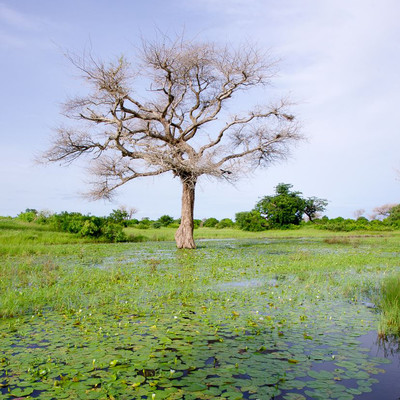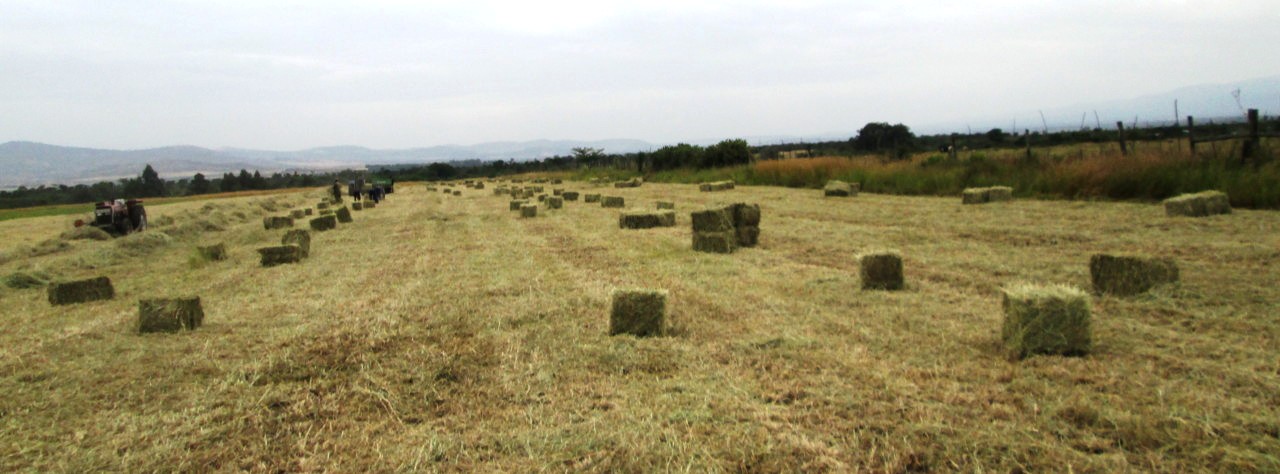ECHOcommunity更新
5 "Grow-Your-Own" Mulch Plants for the Tropics 2017-07-25
The tropical forest is constantly self-mulching. After a walk in the woods I usually return with bits of leaves and twigs caught in my hair. Lying in bed at night, my partner and I often hear branches and even whole trees tumbling toward the great soil food web below. This self-mulching is one important piece in the self-renewing fertility cycle of the tropical forest. And of all the functions of the forest that we can seek to mimic, generating and applying our own mulch may be the most important.
Mulch has many familiar functions, like reducing soil temperature and maintaining higher moisture levels. But all of these means really flow toward one perfect end: feeding and housing the microbial soil community. It is this community that runs the engine which results in a healthy, happy, and abundant permaculture farm.
EDN Issue 136 - Now Available 2017-07-17
In This Issue:
Crop monitoring for early detection of insect pests
A mystery lychee-related illness is solved
Do all parts of a chaya plant contain hydrocyanic acid?
Echoes from our Network: Women and Agriculture response from Sara Delaney on Farming as a Family Business
From ECHO's Seed Bank: Are my seeds dry enough?
eBook Releases: Crop Options to Improve Human Nutrition and Ways to Diversify the Smallholder Farm
Crop monitoring for early detection of insect pests
by Clare Liptak and Dr. Timothy Motis
EXCERPT: Walking through a field to observe pest problems is an important part of any monitoring approach. However, many insects are active at night when it would not be practical for a farmer to be in the field or garden. There are also days when the farmer is away. These limitations are overcome, at least in part, by using any type of container or device that traps enough insects to give the farmer an indication of what pest species are present. Insects can also be attracted to baits that are liquid (e.g., sugar dissolved in water) or solid (e.g., fruit slices or animal dung). Containers are typically filled with water, until 2 cm below the top of the container. Once insects are drawn into a trap, they eventually fall into the water. Add some liquid dish detergent to the water to help prevent trapped insects from escaping. One spoonful (about 15 ml) of dish detergent per container of water should be plenty; use unscented brands to keep smell from skewing the number of trapped insects. As an alternative to using containers, colored pieces of paper or cardboard can be painted with something sticky, like molasses, to capture insects.
Creative Livelihood Challenge training takes innovative products to market 2017-07-11
A recent Creative Livelihood Challenge (CLC) training was conducted with 15 students from Arusha Technical College and 15 Creative Capacity Building innovators. This type of training was developed and facilitated by Elizabeth Reece – an Australian volunteer who is based at Twende in Tanzania.
CLC training is similar to Creative Capacity Building (CCB) but focuses on the business side of bringing products to market. To understand the methodology of CLC it is helpful to understand how Creative Capacity Building is designed:
“The goal of CCB is to train participants to create or adapt technologies that will improve their lives and strengthen their communities. By distilling key elements of the design process into a hands-on curriculum that is accessible at any educational level, CCB presents a framework through which anyone can become an active creator of technology, not just a recipient or user of technology.”
Fertilizer Trees – Guest Post 2017-06-20
No, fertilizer as we normally think of it doesn’t grow on trees! But agroforesters and other agriculturalists are using this term for any tree that helps improve the quality of soil. One great example is the Apple Ring Acacia (Faidherbia albida). The Apple Ring Acacia is an unusual tropical nitrogen-fixing tree in that it drops its leaves in the rainy season thus adding some fertility to the soil underneath. It then leafs back out in the dry season. In temperate climates that would sort of be like our trees losing their leaves in the summer and leafing out in the winter!
Students volunteer to dig contours in East Africa 2017-06-11
Restoration of Green Environment and Eradication of Poverty in Tanzania (RGEEPT) and Rural Community Network (RUCONET) are local NGOs whose work is among communities in Northeastern Tanzania. This month they received 23 visitors from Belmont College, Nashville, TN through a local tour operator, to come for 2 1⁄2 days to work alongside farmers to seek to improve the environment in 2 sub-villages of Lemanyata and Lengijave villages.
Agricultural Risk Assessment and Management 2017-05-30
These resources were recently shared by Steve Hodges of African Agriculture Risk Management Services. This is an excellent example of how ECHOcommunity members can benefit others by sharing their work. To find out more about publishing resources on ECHOcommunity.org check out ECHO Intellectual Property and Sharing.
Except: Basic Criteria for Evaluating and Managing Risks
Within the internationally recognized field of agricultural risk assessment and management, all of
these risks of these many categories can be evaluated according to three basic criteria :
1. Impact: In other words, how severe will the risk event be if it actually happens? Some
risks can destroy the whole year's farm income and even destroy assets; other risks are milder in
impact.
2. Likelihood How likely is this risk to come about? Some risks are rare and unpredictable,
others are more likely to happen.
3. Manageability Independent of how severe or how likely a risk is, some risks are out of
the control of the farmer, others can be handled to a large or small degree. It makes sense to
prioritize scarce resources on risks which can actually be managed
Seed banks and seed swaps - focusing worldwide on healthy local seed systems 2017-05-22
Seed availability for small-scale farmers can be unpredictable and unreliable. Commercial products are often out of reach financially or geographically and can lead to loss of biodiversity. ECHO's seed banks provide sample packets of seeds to evaluate for potential crop production in challenging places. This free service fills an important need, but is one part of a holistic, successful, and sustainable crop cycle.
ECHO promotes strengthening local seed systems though seed saving, local banking, and seed fairs - also known as seed swaps. Seed swaps have proven to be highly successful events allowing development workers, farmers and gardeners to identify the wealth of local crop varieties and exchange valued plant materials for expanded propagation and production.
Seeds Seed Fair Seed Bank Seed Exchange Seed Sources Seed Saving
New Publication: ECHO Central America / Caribbean Notes 2017-05-09
The first edition of ECHO Central America / Caribbean Notes (CACN) presented the article “Making Silage in Vichada“written by Dexter B. Dombro. From this article we learned that silage is an important supplement to feed livestock during long droughts when grasses dry up and lose nutrients.
Silage is a farm product made from fresh cut grasses or other green forage matter, mixed with molasses, compacted and hermetically sealed and stored. Silage, as cattle feed, offer some important advantages. From a nutritional point of view, silage conserves most of the nutrients of fresh cut grasses; while hay, which is dried grasses, loses most of its nutrients. Silage, as a farm product, is economical as it eliminates the cost of transportation.
GUEST POST: End Of Hay Baling Season - Lessons Learned 2017-05-02
ECHOcommunity member Anne Munene is a hay farmer, trainer, consultant and blogger in Nanyuki Kenya. This week's post is from her blog "Lukuai Hay Farm" originally posted here: https://lukuaihayfarm.wordpress.com/2016/09/28/end-of-hay-baling-season-lessons-learnt/
We are close to the end our baling season and what a time we have had; with challenges that could fill a barn and lessons from sources that we didn’t expect. On a very personal level I have had tremendous support from the Lukuai Farm staff and neighbours, for which I am truly grateful.
In this post I mainly want to address the challenges in hay production especially at a time when there is a new hype that pesa iko kwa hay. Ok, that if you have some idle land and plant “hay”, this will be better than betting. You will get rich, and very fast while we are at it, with the best part being that you don’t have to sweat it out, it is easy money.
Aaah, I guess I stood on the wrong side of this mythical generous wind that blows money into hay producers, while still allowing them to live the easy life of lounging about.
A Snapshot from Bangladesh: Building Farmer-Extension Relationships 2017-04-25
With 160 million people living in an area the size of the US state of Georgia, cropland is not an overly abundant resource in the country of Bangladesh. In order to meet the ever growing needs of its population, it is not uncommon for farmers in this delta nation to produce 3 consecutive seasons of rice on the same piece of land in a given calendar year. This relatively recent intensification of the land doesn’t come without its costs, and relies heavily on expensive external inputs, a dwindling of irrigation water resources, and an uninterrupted invitation extended to crop pests and diseases.









